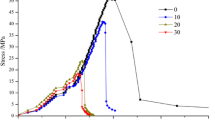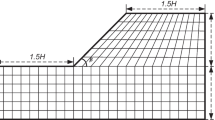Abstract
The change in rock mechanical properties during the freeze-thaw (F-T) cycles is crucial to study the stability of slope engineering in cold regions. In this paper, the rock on the slope of the road along the Yalu River is selected for creep test under freeze-thaw conditions. Then, the mechanical parameters of the rock mass are determined by parameter identification and model verification. Next, based on the Cvisc model in FLAC3D, the stability of the highway slope is calculated by the strength reduction method (SRM) with the consideration of creep characteristics of the rock under freeze-thaw conditions and the creep curves of the monitoring points under different reduction factors are obtained. Finally, the displacement variation of the creep curve is analyzed and compared with the monitoring data to verify the correctness of the model, and it determines the safety factor of the slope engineering considering the creep characteristics under freeze-thaw conditions. It proves that the F-T cycles and creep characteristics of rock mass have negative effects on the long-term stability of slope engineering. Therefore, during the design process of slope engineering, the influence of F-T cycles and creep characteristics on the slope should be considered.














Similar content being viewed by others
References
Berisavljević Z, Berisavljević D, Čebašek V, Rakić D (2015) Slope stability analyses using limit equilibrium and strength reduction methods. Gradevinar 67(10):975–983
Chang W, Wang P, Wang HJ et al (2021) Simulation of the Q2 loess slope with seepage fissure failure and seismic response via discrete element method. Bull Eng Geol Environ 80(3):1–17
Chen WB, Zheng YR, Feng XT, Zhao SY (2008) Study on strength reduction technique considering creep property of rock and soil medium. Rock Soil Mech 29(1):101–105
Chen T, Deng JH, Sitar N, Zheng J et al (2017) Stability investigation and stabilization of a heavily fractured and loosened rock slope during construction of a strategic hydropower station in China. Eng Geol 221:70–81
Dawson EM, Roth WH, Drescher A (1999) Slope stability analysis by strength reduction. Geotechnique 49(6):835–840
Day RW (1997) State of the art: limit equilibrium and finite-element analysis of slopes – discussion. J Geotech Geoenviron 123(9):894–894
Feng ZY, Chen SH (2021) Discussions on landslide types and seismic signals produced by the soil rupture due to seepage and retrogressive erosion. Landslide 18(2):1–15
Furuya G, Sassa K, Hiura H, Fukuoka H (1999) Mechanism of creep movement caused by landslide activity and underground erosion ill crystalline schist, Shikoku Island, southwestern Japan. Eng Geol 53(3–4):311–325
Griffiths DV, Lane PA (1999) Slope stability analysis by finite elements. Geotechnique 49(3):387–403
Izadi A, Kalourazi AF, Chenari RJ (2021) Effect of roughness on seismic bearing capacity of shallow foundations near slopes using the lower bound finite element method. International Journal of Geomechanics 21(3):1–11
Jamshidi A, Nikudel MR, Khamehchiyan M (2013) Predicting the long-term durability of building stones against freeze-thaw using a decay function model. Cold Reg Sci Technol 92:29–36
Kolay E (2016) Modeling the effect of freezing and thawing for sedimentary rocks. Environ Earth Sci 75(3):1–12
Korshunov AA, Doroshenko SP, Nevzorov AL (2016) The impact of freezing-thawing process on slope stability of earth structure in cold climate. Procedia Engineering 143:682–688
Li J, Zhou K, Liu W, Zhang Y (2018) Analysis of the effect of freeze-thaw cycles on the degradation of mechanical parameters and slope stability. Bull Eng Geol Environ 77(2):573–580
Liu C, Deng H, Zhao H, Zhang J (2018) Effects of freeze-thaw treatment on the dynamic tensile strength of granite using the Brazilian test. Cold Reg Sci Technol 155:327–332
Ma Z, Liao H, Dang F et al (2020) Seismic slope stability and failure process analysis using explicit finite element method[J]. Bulletin of Engineering Geology and the Environment 80(5):1–15
Ma ZY, Liao HJ, Dang FN, Cheng YX (2017a) Seismic slope stability and failure process analysis using explicit finite element method. Bull Eng Geol Environ 80(5):1287–1301
Ma JZ, Zhang J, Huang HW, Zhang LL, Huang JS (2017b) Identification of representative slip surfaces for reliability analysis of soil slopes based on shear strength reduction. Comput Geotech 85:199–206
Sasaki Y, Fujii A, Asai K (2000) Soil creep process and its role in debris slide generation - field measurements on the north side of Tsukuba Mountain in Japan. Eng Geol 56(1–2):163–183
Stead D, Eberhardt E, Coggan JS (2006) Developments in the characterization of complex rock slope deformation and failure using numerical modelling techniques. Eng Geol 83(1–3):217–235
Sun C, Chai J, Xu Z, Qin Y, Chen X (2016) Stability charts for rock mass slopes based on the Hoek-Brown strength reduction technique. Eng Geol 214:94–106
Tan X, Chen W, Yang J, Cao J (2011) Laboratory investigations on the mechanical properties degradation of granite under freeze-thaw cycles. Cold Reg Sci Technol 68(3):130–138
Tschuchnigg F, Schweiger HF, Sloan SW (2015) Slope stability analysis by means of finite element limit analysis and finite element strength reduction techniques. Part I: numerical studies considering non-associated plasticity. Comput Geotech 70:169–177
Tu Y, Liu X, Zhong Z, Li Y (2016) New criteria for defining slope failure using the strength reduction method. Eng Geol 212:63–71
Yuan W, Bai B, Li XC, Wang HB (2013) A strength reduction method based on double reduction parameters and its application. J Cent South Univ 20(9):2555–2562
Yuan W, Li JX, Li ZH (2020) A strength reduction method based on the generalized Hoek-Brown (GHB) criterion for rock slope stability analysis. Comput Geotech 117:1–16
Zheng H, Sun GH, Liu DF (2009) A practical procedure for searching critical slip surfaces of slopes based on the strength reduction technique. Comput Geotech 36(1–2):1–5
Funding
This work was supported by the National Natural Science Foundation of China (No. 51678101, No. 52078093), the LiaoNing Revitalization Talents Program (Grant No. XLYC1905015), and the Doctoral innovation Program of Dalian Maritime University (Grant No: BSCXXM015).
Author information
Authors and Affiliations
Corresponding author
Ethics declarations
Conflict of interest
The authors declare that they have no competing interests.
Additional information
Responsible editor: Zeynal Abiddin Erguler
Rights and permissions
About this article
Cite this article
Yang, X., Jiang, A. & Zheng, S. Analysis of the effect of freeze-thaw cycles and creep characteristics on slope stability. Arab J Geosci 14, 1033 (2021). https://doi.org/10.1007/s12517-021-07290-1
Received:
Accepted:
Published:
DOI: https://doi.org/10.1007/s12517-021-07290-1




